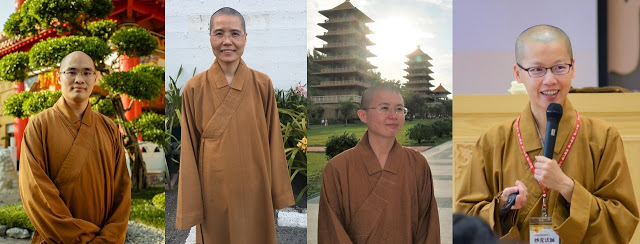
From left to right: Ven. Hui Cheng, Ven. Miao Zhong, Ven. You Lu, Ven. Miao Guang
From the Four Immeasurables to the Four Givings, from global interconnectedness to perceiving the essence of all phenomena, this month’s Dharma talks invite us to open ourselves and embrace others with wholesome thoughts and actions. Here are the highlights of episodes 9 to 12.
Dharma Talk 9
Topic: The Four Immeasurables—Going Beyond the Spiritual Workout
Speaker: Ven. Hui Cheng
What are the attitudes should we maintain towards others? This week, Venerable Hui Cheng gives an in-depth guide on the Four Immeasurable States of Mind—Loving-kindness, Compassion, Appreciative Joy, and Equanimity. This is a practice that benefit both self and others, for only by giving the best of ourselves to others do we truly experience joy.
Excerpt from Dharma Teaching:

What are the Four Immeasurables?
They are the active mental states of Loving kindness, Compassion, Appreciative Joy and Equanimity, or in other words, four attitudes we maintain towards others. They become Immeasurable when we extend such attitudes to all beings everywhere without differentiation or prejudice, be it our relatives, friends, acquaintances, strangers, or even our nemeses for that matter. Since we are also sentient beings, such attitudes need also be directed at oneself.
It is inevitable that we have certain negative mental factors lying dormant in the depths of our mind which often go undetected, waiting for the right conditions to manifest as active mental states. To this end, the practice of the Immeasurables may address these.According to the Mahaprajnaparamita Sastra:
i. Loving kindness is practiced to remove hostility toward beings
ii. Compassion is practiced to remove harm and cruelty toward beings.
iii. Appreciative joy is practiced to remove dissatisfaction and jealousy toward beings
iv. Equanimity is practiced to remove clinging and aversion.
Dharma Talk 10
Topic: The Rainbow of Life
Speaker: Ven. Miao Zhong
When we see a rainbow after a storm, it us brings joy, hope, and peace, but do you know that you can also give rainbows to others? This week, Venerable Miao Zhong explains the giving rainbows—the Four Givings—and how we can bring confidence, joy, hope, and convenience to others.
Excerpt from Dharma Teaching:
Rainbow usually appear after storm, so people often think of rainbow as hope. Some might think of peace and serenity. Because of the spectrum of colors, some people feel joyful seeing it. In modern times, people also relate rainbow with gay pride, representing diversity and acceptance. Rainbows are wonder phenomena in our life that brings us so much positive and beautiful meaning.
Right now, the coronavirus pandemic is challenging our health, work, family, food, and fun. It is this course of time that we need more rainbows to bring us the joy, hope, and peace. But how can we create more of these beautiful rainbows in our lives? Well, it can be done by practicing the Four Givings taught by Venerable Master Hsing Yun.

The Four Givings are:
Giving others confidence
Giving others hope
Giving others joy
Giving others convenience
These practices are ways that we can form rainbows, not only in our lives, but also to everyone around us.
Dharma Talk 11
Topic: Lessons from the Mouse
Speaker: Ven. You Lu
The Mouse, small as it may be, is intelligent and clever. This week, Venerable You Lu tells us two stories about the small mouse, and a lesson in interconnectedness. Do not underestimate what may seem small, for it may have a huge impact on our lives.
Excerpt from Dharma Teaching

First, do not underestimate or look down upon the small. We should be mindful about every small act or deed we make, because if we are reckless, something small like the coronavirus can turn itself into a pandemic and create suffering on a massive scale. Fortunately, over the past two to three months, people have started to cultivate small habits of good hygiene… Not only do we need to cultivate good hygienic habits, we also need to cultivate good moral habits, like protecting lives, speaking truthfully, and rejoicing in the good acts of others.
Secondly, we need to realize that we are all inter-connected, and so it is important for us to act responsibly as a global citizen…As a global citizen in this web of interconnectedness, we need to be aware of lives around us, not merely other human beings, but also living creatures, birds, fishes and animals, and the natural world. So instead of taking lives and feeding on lives, we should learn to protect lives.
Dharma Talk 12
Topic: Heart Sutra—An Introduction
Speaker: Ven. Miao Guang
Excerpt from Dharma teaching:
The Heart Sutra is one of the most popularly recited sutras. With its short length, many Buddhists have it committed to memory and chant it as their daily practice. So what is the Heart Sutra about? This week, Venerable Miao Guang gives an introduction of this important sutra by discussing the three levels of emptiness. May all attain the perfection of prajna wisdom!
The Heart Sutra in a nutshell, the teachings of Avalokiteshvara helps us understand emptiness on three levels:
1. Emptiness of the self: where we will no longer hold onto the notion of self as something true or eternal. It’s constantly changing, it’s not real, and it should not be something that controls us.
2. Emptiness of all phenomena: we understand the emptiness of all phenomena. Even the reality of death, the reality of dukkha can be something that, once we attain the insight of Prajna-Paramita, can eventually overcome.

3. Emptiness of concepts: Ultimately, what Avalokitesvara wants to tell us this the emptiness of concept whereby saying that there’s no wisdom nor attainment, Avalokitesvara Bodhisattva reminds us that the raft which carries us across the ocean or the river of birth and death across to the far shore of nirvana or enlightenment eventually will have to be abandoned, because they are after all only conventional. The way bodhisattvas overcome the emptiness of the concepts is by blending both ends of dualism. To see self as other, to see good as bad, or to see all of these together as parts of the self. Just like the mother, all the good and bad experienced by her baby or her child will be parts of her. In order to really reach that state, we’ll have to rely on our ability to slowly let go of our ego and attachment to what we think is reality.
Thank you for supporting FGS English Dharma Services. We hope that our weekly Dharma talks have been helpful to you. Stay tune for more videos on the Buddha-Dharma!
